Dispatching systems in power engineering and on the railway
IP-telephony has long been used in corporate telephone systems and PSTN. But technological dispatching telephone communication systems in such departments as the management of railway transportation and electricity transmission networks still use classical TDM telephony, or analog equipment. The peculiarity of these dispatching systems is that the work of the managing dispatcher and the controlled supervised duty facility (electrical substation or railway station) is strictly regulated by industry standards and rules. Often these rules derive from the technical limitations of the original analog dispatch systems.
Dispatching systems in power engineering and railway require additional special functions that are not able to implement standard telecommunication protocols (such as, for example, analog frequency alarms such as R1.5, R2, DTMF, which send control frequencies / tones to the tone frequency channel in voice transmission), therefore, departmental telephone communication systems ADASE for energy and OTS for railway transport were developed.
In the ADASE network, there are 2 types of subscribers: a remote subscriber (this can be a telephone set, or a PBX), and a dispatcher. ADASE equipment used analog channels of tone frequency (PM), which were transmitted using high-frequency communications equipment over the wires of overhead power lines (HF over HL) from the control center to the controlled substation where the person on duty is located.
Such a telephone communication system provides for the establishment of subscriber - subscriber, dispatcher - subscriber connections. Due to the limited resource of the trunk connection between the substation and the control center (one or several analog PM channels) and the need for the dispatcher to ensure the priority of the channel occupation, the intra-channel frequency signaling ADASE was developed.
')
Typical scheme of construction ADASE:
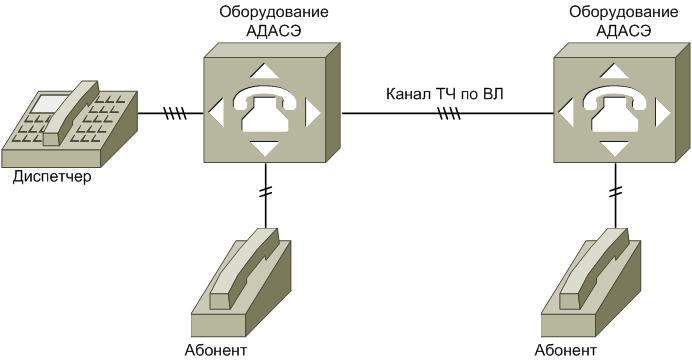
In addition to the standard functions of the occupation, release of the channel, dialing, sending signals "busy" / "free", the ADASE alarm system provides the dispatcher's priority during the occupation of the PM channel. That is, the dispatcher has the right to break the conversation of a lower priority (for example, the subscriber is the subscriber) who occupied the PM channel, followed by automatic occupation (the dispatcher is the subscriber), or intervene in the conversation (thus creating a three-party conference), followed by manual break (before sending the corresponding control frequencies to the channel).
In operational and technological communications on the railway, there are 2 types of stations: administrative, which is installed in the control center, and to which dispatching telephones are connected, and executive telephone, to which telephones, for example, the station attendant are connected.
Such a system allows you to create a so-called "group channel" or a distributed conference to which the dispatcher and attendants are connected. The attendant’s console is equipped with a pedal. In the normal position, the dispatcher can listen to the conference, but when the pedal is pressed, all the attendants will turn off the microphones, and then only the dispatcher speaks to the conference. Devices on duty are equipped with a PTT (like push-to-talk). Attendants speak to the conference only when the tangent is pressed.
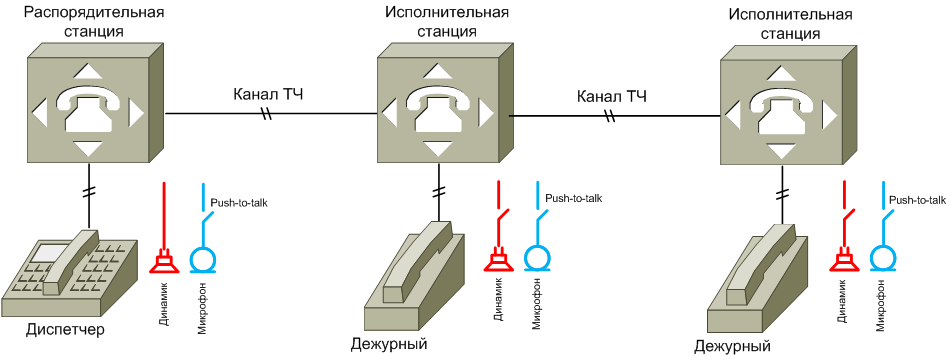
UTS alarm (two or more consecutive frequencies in the channel from 7 possible in the tonal range) allows the dispatcher to make group calls (only a group of subscribers of executive stations), circular (all subscribers of executive stations) or individual. With the help of the control frequency of the reverse and direct control, the logic of the operation of the pedal of the dispatcher and the tangent of the duty personnel is organized. In addition, analog signaling allows you to display on the remote dispatcher the subscribers connected to the conference and those who are dialed.
The structure of OTS includes various types of communication: distillation, road distribution, etc. They use different analog connection lines (2 or 4 wired), but the logic of operation remains the same.
Digital PBX manufacturers have implemented support for these analog alarms. In addition, digital devices with an ISDN BRI interface were supported as dispatcher devices (which, for example, made it possible to increase the length of the connecting line to 1000m).
In the case of ADASE, standard E1 with ISDN signaling is used as trunk connections between stations, so ensuring the priority of the dispatcher's occupation is not so important here - it always (with incomplete loading of trunks) can take additional timeslot. The ADASE alarm system itself is supported on the last mile sections, where there is no possibility of organizing E1, as well as on the subscriber interfaces of the PBX to support analog dispatcher consoles.
Typical application of digital PBX with ADASE
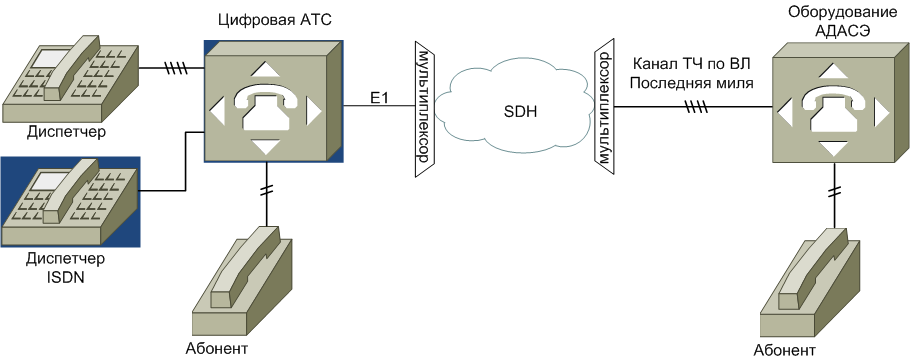
In the case of UTS, the analog signaling provided complex functions (monitoring the connection status of subscribers to the conference, the priority of the controller’s voice in the conference), which resulted in the refinement of ISDN Q.931 signaling for their implementation. Such ISDN-like signaling is described in the industry standard digital OTS 35 145-2000. Digital PBX systems retained analog signaling support on subscriber interfaces to enable the connection of analogue consoles. In such a case, the PBX works as a converter of signaling between analog intra channel and digital.
Typical application of digital PBX for OTS
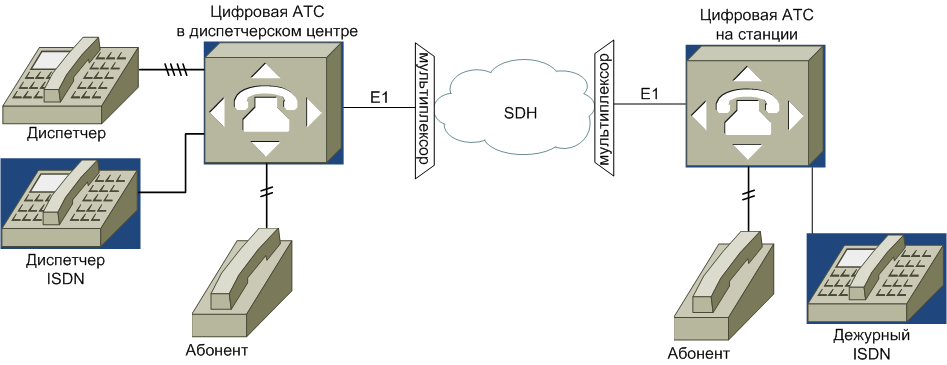
As well as in electric power industry, and in the dispatching control of railway transport, the main reasons for replacing digital PBXs installed 20 years ago are:
1) PBX obsolescence, lack of technical support and spare parts
2) Limited ISDN functionality of dispatchers: insufficient number of speed dial buttons, lack of head and DECT headsets
3) The need to integrate video conferencing and video surveillance
4) Limited observability and equipment controllability.
5) Limited scalability with an increase in the number of controlled objects.
From the point of view of modern IP-telephony systems, ADASE or group channels are conferences with an extended set of functions: interference and forced disconnection of subscribers, presence, invitation of subscribers to a conference by sending a call.
Problems arising from the use of IP-telephony for dispatching systems:
1) Presence (monitoring the connection status of subscribers to the conference)
In the case of ADASE, the dispatcher's terminal device needs to display the state of the end device of the controlled object on duty (whether it is a telephone connected via an analog line or a VoIP endpoint) - whether the call is ringing (using color signaling), is the subscriber talking at the moment, or is the subscriber free to making a call. Also, in the case of working with analog lines, the dispatcher needs to see the line occupation and the identifier of the neighboring dispatcher (or a low-priority subscriber) who occupied it.
In the case of an OTN, the dispatcher's final device must display graphically the subscribers already connected to the conference. In addition, the dispatcher can be a participant in several conferences and see which of the slave subscribers is connected to each of the conferences.
2) Intervention
The intervention procedure (Barge-in) is applied only in ADASE. Regardless of the type of terminal device of the slave subscriber, the dispatcher must determine who the particular attendant is talking to with whom and, if necessary, break the existing connection (low priority subscriber to the attendant) and automatically connect to this attendant (create a dispatcher / attendant connection).
3) Distributed Conference in JTS
In current UTS systems, the interruption of communication between the dispatch center and station A does not make it impossible to make a call between stations A and B. Using the same VoIP conference server in the control center makes such connections impossible (if the connection is broken). Therefore, it is recommended to use a distributed conference with the installation of conference servers on most stations in OTN VoIP systems. However, this architecture increases the complexity of managing conferences, and also greatly increases the delay in voice transmission.
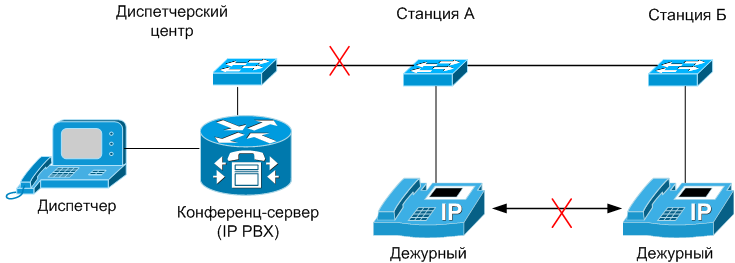
4) Joint with analog lines
A large number of already installed analog lines and ADASE and OTS subscribers does not allow switching to VoIP completely. Therefore, conference servers must support intra-channel analog frequency alarms. Modern CPUs allow processing of such signaling at the program level without the use of expensive DSPs. Therefore, the interface with analog lines can be organized as follows: the line is connected to the E1 multiplexer to the corresponding interfaces matched in terms of physical parameters with the line. The analog signal from the line is digitized and at the output of the multiplexer is one of the 64kbps E1 stream timeslots (in this case, the E1 signaling is not important, since in the analog line the signaling is transmitted in the PM band). A conference server (a standard server with a PCI E1 card) at the program level processes a specific time slot and analyzes the signaling.

5) The priority of the dispatcher's voice in the conference
In analog dispatch communication systems (in particular, OTS), the dispatcher's conversation with the subordinate subscriber took place in simplex mode, and the dispatcher could interrupt the subscriber by voice: when the dispatcher speaks, the equipment muffles the subscriber's speech. In modern systems, all conversations occur in full-duplex mode, but sometimes internal schedules of dispatchers require you to ensure the priority of the dispatcher's voice.

6) Apply PTT Tangent and Pedals
In the OTN systems, telephones (digital ISDN or analog) with a push-to-talk button (tangent) on the handset are used as terminal subscriber devices. In some cases, push-to-talk foot pedal is also used. Modern VoIP phones are rarely equipped with such tangents and pedals. An example of such a phone device: Cisco 79xx with a Plantronics WS-2620 handset.
7) Dispatcher end devices.
Modern concepts of development of dispatching systems suggest using monoblocks with touch screens, which run soft phones with the necessary set of functions, as dispatchers' devices. The main requirements for such devices: reliability (for example, the absence of fans), low power consumption (perhaps even powered by PoE), a set of peripheral devices (DECT / Bluetooth headsets, PTT, remote microphones).
At the moment, VoIP is approved for use in the power industry and on the railway. The main task in the implementation of such systems is to make them as similar as possible to the already used ones, as well as ensure the interface with those already installed.
About me: I work as a leading engineer in a company that develops such systems for energy and railway companies in Eastern Europe and Russia
Departmental Analog Dispatch Systems
Dispatching systems in power engineering and railway require additional special functions that are not able to implement standard telecommunication protocols (such as, for example, analog frequency alarms such as R1.5, R2, DTMF, which send control frequencies / tones to the tone frequency channel in voice transmission), therefore, departmental telephone communication systems ADASE for energy and OTS for railway transport were developed.
Equipment for Long-Distance Automatic Communication of Power Systems - ADASE 1200/1600
In the ADASE network, there are 2 types of subscribers: a remote subscriber (this can be a telephone set, or a PBX), and a dispatcher. ADASE equipment used analog channels of tone frequency (PM), which were transmitted using high-frequency communications equipment over the wires of overhead power lines (HF over HL) from the control center to the controlled substation where the person on duty is located.
Such a telephone communication system provides for the establishment of subscriber - subscriber, dispatcher - subscriber connections. Due to the limited resource of the trunk connection between the substation and the control center (one or several analog PM channels) and the need for the dispatcher to ensure the priority of the channel occupation, the intra-channel frequency signaling ADASE was developed.
')
Typical scheme of construction ADASE:

In addition to the standard functions of the occupation, release of the channel, dialing, sending signals "busy" / "free", the ADASE alarm system provides the dispatcher's priority during the occupation of the PM channel. That is, the dispatcher has the right to break the conversation of a lower priority (for example, the subscriber is the subscriber) who occupied the PM channel, followed by automatic occupation (the dispatcher is the subscriber), or intervene in the conversation (thus creating a three-party conference), followed by manual break (before sending the corresponding control frequencies to the channel).
Operational and technological communication - OTS.
In operational and technological communications on the railway, there are 2 types of stations: administrative, which is installed in the control center, and to which dispatching telephones are connected, and executive telephone, to which telephones, for example, the station attendant are connected.
Such a system allows you to create a so-called "group channel" or a distributed conference to which the dispatcher and attendants are connected. The attendant’s console is equipped with a pedal. In the normal position, the dispatcher can listen to the conference, but when the pedal is pressed, all the attendants will turn off the microphones, and then only the dispatcher speaks to the conference. Devices on duty are equipped with a PTT (like push-to-talk). Attendants speak to the conference only when the tangent is pressed.

UTS alarm (two or more consecutive frequencies in the channel from 7 possible in the tonal range) allows the dispatcher to make group calls (only a group of subscribers of executive stations), circular (all subscribers of executive stations) or individual. With the help of the control frequency of the reverse and direct control, the logic of the operation of the pedal of the dispatcher and the tangent of the duty personnel is organized. In addition, analog signaling allows you to display on the remote dispatcher the subscribers connected to the conference and those who are dialed.
The structure of OTS includes various types of communication: distillation, road distribution, etc. They use different analog connection lines (2 or 4 wired), but the logic of operation remains the same.
Transition to digital systems (90s)
Digital PBX manufacturers have implemented support for these analog alarms. In addition, digital devices with an ISDN BRI interface were supported as dispatcher devices (which, for example, made it possible to increase the length of the connecting line to 1000m).
In the case of ADASE, standard E1 with ISDN signaling is used as trunk connections between stations, so ensuring the priority of the dispatcher's occupation is not so important here - it always (with incomplete loading of trunks) can take additional timeslot. The ADASE alarm system itself is supported on the last mile sections, where there is no possibility of organizing E1, as well as on the subscriber interfaces of the PBX to support analog dispatcher consoles.
Typical application of digital PBX with ADASE

In the case of UTS, the analog signaling provided complex functions (monitoring the connection status of subscribers to the conference, the priority of the controller’s voice in the conference), which resulted in the refinement of ISDN Q.931 signaling for their implementation. Such ISDN-like signaling is described in the industry standard digital OTS 35 145-2000. Digital PBX systems retained analog signaling support on subscriber interfaces to enable the connection of analogue consoles. In such a case, the PBX works as a converter of signaling between analog intra channel and digital.
Typical application of digital PBX for OTS

Switch to VoIP
As well as in electric power industry, and in the dispatching control of railway transport, the main reasons for replacing digital PBXs installed 20 years ago are:
1) PBX obsolescence, lack of technical support and spare parts
2) Limited ISDN functionality of dispatchers: insufficient number of speed dial buttons, lack of head and DECT headsets
3) The need to integrate video conferencing and video surveillance
4) Limited observability and equipment controllability.
5) Limited scalability with an increase in the number of controlled objects.
VoIP in industry dispatching systems
From the point of view of modern IP-telephony systems, ADASE or group channels are conferences with an extended set of functions: interference and forced disconnection of subscribers, presence, invitation of subscribers to a conference by sending a call.
Problems arising from the use of IP-telephony for dispatching systems:
1) Presence (monitoring the connection status of subscribers to the conference)
In the case of ADASE, the dispatcher's terminal device needs to display the state of the end device of the controlled object on duty (whether it is a telephone connected via an analog line or a VoIP endpoint) - whether the call is ringing (using color signaling), is the subscriber talking at the moment, or is the subscriber free to making a call. Also, in the case of working with analog lines, the dispatcher needs to see the line occupation and the identifier of the neighboring dispatcher (or a low-priority subscriber) who occupied it.
In the case of an OTN, the dispatcher's final device must display graphically the subscribers already connected to the conference. In addition, the dispatcher can be a participant in several conferences and see which of the slave subscribers is connected to each of the conferences.
2) Intervention
The intervention procedure (Barge-in) is applied only in ADASE. Regardless of the type of terminal device of the slave subscriber, the dispatcher must determine who the particular attendant is talking to with whom and, if necessary, break the existing connection (low priority subscriber to the attendant) and automatically connect to this attendant (create a dispatcher / attendant connection).
3) Distributed Conference in JTS
In current UTS systems, the interruption of communication between the dispatch center and station A does not make it impossible to make a call between stations A and B. Using the same VoIP conference server in the control center makes such connections impossible (if the connection is broken). Therefore, it is recommended to use a distributed conference with the installation of conference servers on most stations in OTN VoIP systems. However, this architecture increases the complexity of managing conferences, and also greatly increases the delay in voice transmission.

4) Joint with analog lines
A large number of already installed analog lines and ADASE and OTS subscribers does not allow switching to VoIP completely. Therefore, conference servers must support intra-channel analog frequency alarms. Modern CPUs allow processing of such signaling at the program level without the use of expensive DSPs. Therefore, the interface with analog lines can be organized as follows: the line is connected to the E1 multiplexer to the corresponding interfaces matched in terms of physical parameters with the line. The analog signal from the line is digitized and at the output of the multiplexer is one of the 64kbps E1 stream timeslots (in this case, the E1 signaling is not important, since in the analog line the signaling is transmitted in the PM band). A conference server (a standard server with a PCI E1 card) at the program level processes a specific time slot and analyzes the signaling.

5) The priority of the dispatcher's voice in the conference
In analog dispatch communication systems (in particular, OTS), the dispatcher's conversation with the subordinate subscriber took place in simplex mode, and the dispatcher could interrupt the subscriber by voice: when the dispatcher speaks, the equipment muffles the subscriber's speech. In modern systems, all conversations occur in full-duplex mode, but sometimes internal schedules of dispatchers require you to ensure the priority of the dispatcher's voice.

6) Apply PTT Tangent and Pedals
In the OTN systems, telephones (digital ISDN or analog) with a push-to-talk button (tangent) on the handset are used as terminal subscriber devices. In some cases, push-to-talk foot pedal is also used. Modern VoIP phones are rarely equipped with such tangents and pedals. An example of such a phone device: Cisco 79xx with a Plantronics WS-2620 handset.
7) Dispatcher end devices.
Modern concepts of development of dispatching systems suggest using monoblocks with touch screens, which run soft phones with the necessary set of functions, as dispatchers' devices. The main requirements for such devices: reliability (for example, the absence of fans), low power consumption (perhaps even powered by PoE), a set of peripheral devices (DECT / Bluetooth headsets, PTT, remote microphones).
At the moment, VoIP is approved for use in the power industry and on the railway. The main task in the implementation of such systems is to make them as similar as possible to the already used ones, as well as ensure the interface with those already installed.
About me: I work as a leading engineer in a company that develops such systems for energy and railway companies in Eastern Europe and Russia
Source: https://habr.com/ru/post/223841/
All Articles